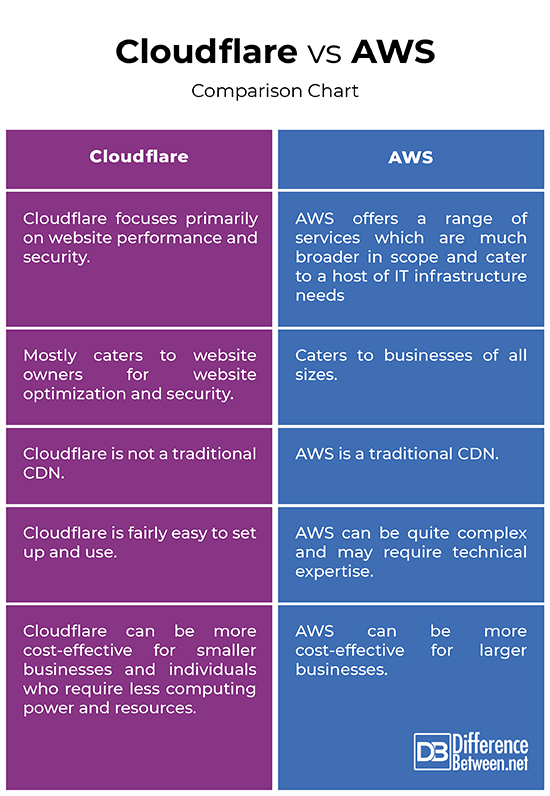Difference Between Cloudflare and AWS
Cloudflare and AWS are probably two of the most prominent names in the CDN space. They are among the most popular cloud-based platforms used by businesses of all sizes these days. The ever increasing demands for high-quality internet videos have pushed content delivery network (CDN) providers like AWS, Cloudflare, etc. to optimize the user experience, providing value to the consumers. Both Cloudflare and AWS offer cloud-based services, but they differ fundamentally in their core competencies and target audience. Let’s take a look at some key differences between the two.

Cloudflare
Cloudflare is an American content delivery network and a security company with headquarters in San Francisco and offices in Singapore and London. Cloudflare is one of the fastest growing CDN providers hosting over 2 million websites. Cloudflare hosts a group of geographically dispersed servers to efficiently facilitate the distribution of information and data in a timely manner.
Cloudflare provides a host of cloud based services to improve website performance and security, including content delivery network (CDN), DDoS protection, website optimization, domain registration, and SSL/TLS encryption. It also offers a suite of security services to protect websites from online threats, including bot attacks, SQL injection, cross-site scripting, and other vulnerabilities.

Amazon Web Services (AWS)
AWS is a subsidiary of Amazon that provides on-demand web based cloud computing platforms to application providers, ISVs and vendors on a pay-as-you-go basis. AWS uses distributed IT infrastructure to provide several computing resources that are accessible over the internet. It offers more than 200 services, including compute, storage, databases, analytics, machine learning, and more. It allows businesses to host their applications, websites, and other services by providing a flexible and cost-effective solution.
With AWS, businesses can scale their infrastructure up or down based on demand, allowing them to handle large traffic spikes without incurring significant costs. AWS is a reinforcement of Amazon that gives on-demand cloud and APIs to individuals, associations, and governments. Charges depend on a mix of use, equipment/programming/organizing features picked by the subscriber, required accessibility, security, and administration options.
Difference between Cloudflare and AWS
Delivery
– One of the primary differences between the two is that unlike AWS, Cloudflare is not a traditional CDN; it uses a reverse proxy architecture to serve every request through the site. All the requests go through Cloudflare servers and they internally figure out what needs to be cached and what doesn’t. AWS is a traditional CDN that uses Amazon’s global network of edge locations to deliver your web content. Each request is routed to the edge location.
Services
– Cloudflare provides a host of cloud based services to improve website performance and security, including content delivery network (CDN), DDoS protection, website optimization, domain registration, and SSL/TLS encryption. Cloudflare focuses primarily on website performance and security. AWS, on the other hand, also offers a range of services but they are much broader in scope and cater to a host of IT infrastructure needs.
Pricing
– Cloudflare’s pricing is fairly generous and depends on the usage. It offers a free plan that includes basic security features and limited CDN usage. Additional features and more data require you to opt for a paid plan that starts from as low as $20 per month and goes as higher to thousands of dollars. AWS also has a free tier as well, and you will be charged for the amount of computing power, storage, and other resources that you use. AWS can be more expensive than Cloudflare for smaller businesses and individuals who require less computing power and resources.
Cloudflare vs. AWS: Comparison Chart

Summary
In a nutshell, Cloudflare makes for a decent choice when it comes to picking a good CDN for your web projects. It surely is one of the biggest names in the world of CDNs when it comes to scalability of use. And thanks to its free and paid plans, Cloudflare is a popular choice among smaller to medium-sized websites and webmasters. AWS, on the other hand, caters to businesses of all sizes that need to scale their IT infrastructure, providing a host of tools and services to help them deploy applications and analyze data. AWS pricing can be more flexible and customized to meet the specific needs of each business.
Why Cloudflare is better than AWS?
It is not very accurate to say that Cloudflare is better than AWS as both the platforms have their unique strengths and fair share of downsides too. Cloudflare does have some advantages though. For example, Cloudflare is relatively easy to set up and use, and it can be a more cost-effective option for smaller businesses or individuals.
Does Cloudflare compete with AWS?
Both are among the popular names in the CDN ecosystem. Cloudflare manages a global infrastructure of servers that bring data close to users’ locations. That puts Cloudflare in direct competition with some of the biggest names in the CDN space, including AWS.
Why is Cloudflare different?
Cloudflare offers a suite of plugins for all kinds of service providers and content management systems, and unlike most CDN providers, Cloudflare is not a traditional CDN and they have data centers in over 285 cities. It acts as a reverse proxy server to bring server content close to end users.
What is better than Cloudflare?
There are many players in the market that are as good, if not better, than Cloudflare. Some of the popular CDN providers are Google Cloud CDN, StackPath, KeyCDN, Azure CDN, Akamai, and more.
Who is Cloudflare’s biggest competitor?
Some possible alternatives to Cloudflare are Akamai, Fastly, Amazon CloudFront, and Azure CDN.
Why is Cloudflare so popular?
Cloudflare is one of the fastest growing CDN providers hosting over 2 million websites through its global network of geographically dispersed servers. It offers a cost-effective pricing structure which makes it an ideal choice among small businesses and individual users.
- Difference Between Caucus and Primary - June 18, 2024
- Difference Between PPO and POS - May 30, 2024
- Difference Between RFID and NFC - May 28, 2024
Search DifferenceBetween.net :
Leave a Response
References :
[0]Riva, Michael. Real-World Next.js: Build Scalable, High-performance, and Modern Web Applications Using Next.js, the React Framework for Production. Birmingham, United Kingdom: Packt Publishing, 2022. Print
[1]Uzayr, Sufyan bin. Web Performance Optimization: A Practical Approach. Florida, United States: CRC Press, 2022. Print
[2]Baron, Joe, et al. AWS Certified Solutions Architect Official Study Guide: Associate Exam. New Jersey, United States: John Wiley & Sons, 2016. Print
[3]Held, Gilbert. A Practical Guide to Content Delivery Networks. Florida, United States: CRC Press, 2005. Print
